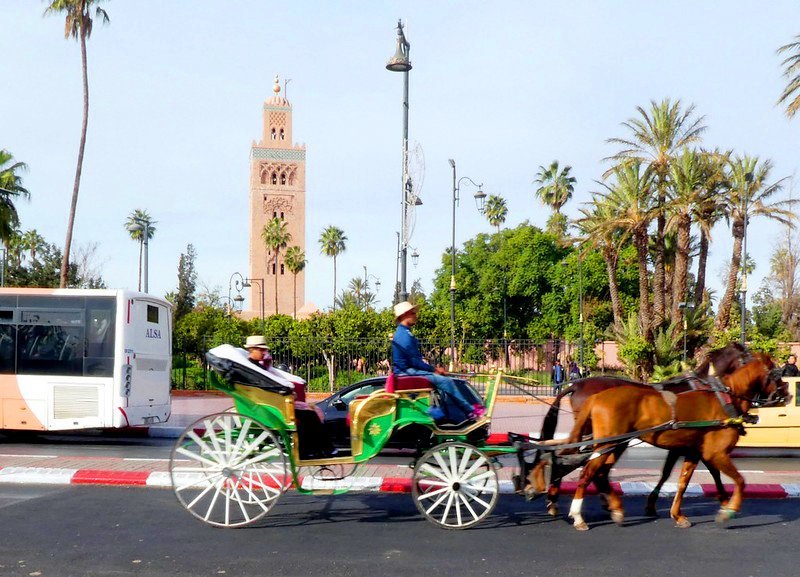Too lazy to read? We summarized everything for you in the FAQ
How the Marrakech Earthquake Affected the Ancient Medina and the Raids
The Marrakech earthquake of September 8, 2023, sent shockwaves through this ancient city, the earth trembled and buildings swayed, the historic medina and jamaa Lafna square, a UNESCO World Heritage site, faced a pivotal moment in its long history. This blog post takes you on a journey through the impact of the earthquake on the Marrakech medina.
jamaa lafna square full of people after two weeks of the marrakech earthquake
The Majestic Koutoubia Mosque: A Timeless Sentinel
One of the most iconic landmarks in Marrakech, the Koutoubia Mosque, has been a silent sentinel to the city's history for nearly nine centuries. Constructed in the 12th century during the Almohad dynasty, this monumental structure has always stood tall, casting its long shadow over the bustling Jemaa el-Fna square.
Intriguingly, the Koutoubia Mosque remained untouched by the earthquake's fury. However, as a precautionary measure, it remains closed to the public until safety experts can affirm its structural integrity. This mosque is not merely a religious center but a symbol of Marrakech's enduring spirit.
Resilience of the Palaces: Bahia Palace and El Badi Palace
Marrakech's rich history as a royal capital is evident in its opulent palaces. The Bahia Palace, a 19th-century masterpiece, was once the residence of the Grand Vizier of Morocco. Its lush gardens and intricate architecture continue to captivate visitors. Similarly, El Badi Palace, a testament to the city's grandeur during the Saadian dynasty, stands resolute, an enduring relic of history.
Miraculously, these palaces emerged from the earthquake unscathed, their intricate designs and grandeur intact. They invite visitors to explore their historical significance, offering glimpses into Marrakech's royal past.
Al Mellah: From History to Resilience
Nestled within the medina, Al Mellah, the old Jewish quarter, is a place steeped in history. Its narrow streets and alleyways tell tales of multiculturalism and coexistence. The recent earthquake did pose challenges to this historic neighborhood. Some of its older buildings, weakened by the passage of time, experienced structural issues, leading to collapses in a few cases and minor cracks in others.
As we contemplate the significance of Al Mellah, let us remember not only its architectural treasures but also the lives and stories woven into its streets. Restoration efforts are underway, a testament to the determination to preserve this unique part of Marrakech's heritage. The resilience of its community shines through as it strives to ensure the endurance of its historical legacy, navigating the challenges posed by time and nature.
Riad Zamzam: A Testament to Strength
Amidst the challenges posed by the earthquake, stories of resilience shine through. Riad Zamzam, a hidden gem within the medina, stands as a testament to human ingenuity and perseverance. When the riad was acquired, a comprehensive renovation project was undertaken, focusing on preserving its historical charm while fortifying its foundations.
Under the guidance of Marcus, an experienced engineer, the riad was rebuilt with meticulous care. The new foundations were engineered to withstand unforeseen challenges. On the day of the earthquake, Riad Zamzam bore the brunt of the seismic forces and emerged unscathed, not a single crack marring its walls.
History of the Marrakech Medina
The Marrakech medina, founded in the 11th century by the Almoravid dynasty, is a testament to architectural and urban planning brilliance. A self-sufficient city with its own markets, mosques, and schools, it was protected by formidable walls that stood as sentinels against invaders.
Over centuries, the medina welcomed diverse cultures, from the Almoravids to the Saadians, and housed a thriving Jewish population. Today, it stands as one of Morocco's most popular tourist destinations, known for its labyrinthine streets, captivating architecture, and vibrant atmosphere.
The Allure of Riads
Riads, traditional Moroccan houses built around central courtyards, are renowned for their intricate tilework and mosaics. They offer tourists a unique and authentic Moroccan experience. Riad Zamzam, an exemplar of this architectural style, is nestled in the heart of the Marrakech medina.
Built in the 17th century and recently renovated, Riad Zamzam boasts a central courtyard with a serene swimming pool, enveloped by lush gardens. It is an oasis where history converges with modern comfort, offering an unforgettable Moroccan experience.
Conclusion: Marrakech's Enduring Spirit
Despite the devastating earthquake, the Marrakech medina stands as a testament to the city's resilience and enduring spirit. Al Koutoubia Mosque, the palaces, and the historic neighborhoods have weathered the storm. Amidst this, Riad Zamzam stands tall, an exemplar of the strength that lies in preserving the past while embracing the future.
Marrakech invites you to explore its rich history, witness its resilience, and become a part of its enduring story. In this ancient city, where history lives on every corner, the earthquake serves as a reminder of Marrakech's unwavering spirit and the strength that emerges from its diverse heritage.
FAQ: The Impact of the Marrakech Earthquake on Historic Sites and Riads
1. What was the impact of the Marrakech earthquake in 2023?
The Marrakech earthquake of September 8, 2023, was a magnitude 6.8 earthquake that caused damage in the region, including the ancient medina.
2. Were iconic landmarks like the Koutoubia Mosque affected?
The Koutoubia Mosque, one of Marrakech's iconic landmarks, was not damaged by the earthquake. However, it remains temporarily closed for safety measurements until experts ensure it's safe.
3. Did the earthquake affect historic palaces in the medina?
The historic palaces in the medina, like the Bahia Palace, are still standing with no damage. The Bahia Palace, known for its beautiful gardens and architecture, remains intact.
4. Which area in the medina was most affected by the earthquake?
Al Mellah, the old Jewish quarter, was the most affected area in the medina due to its old houses and narrow alleys. While some houses collapsed and others suffered minor cracks, restoration efforts are underway.
5. What about the riads in the medina?
The impact on riads varied depending on their structural strength. Some riads were destroyed, while others had minor damage. Riad Zamzam, recently renovated with strong foundations, remained entirely intact.
6. Can you tell me more about the history of the Marrakech medina?
Founded in the 11th century, the Marrakech medina is a UNESCO World Heritage site. It has seen the influence of various dynasties and cultures and is known for its vibrant atmosphere and beautiful architecture.
7. What are riads, and why are they popular among tourists?
Riads are traditional Moroccan houses built around a central courtyard. They feature intricate tilework and mosaics, offering tourists a unique and authentic Moroccan experience.
8. How did Riad Zamzam withstand the earthquake?
Riad Zamzam remained entirely intact during the earthquake due to recent renovations and strong foundations. Marcus, an experienced engineer, ensured the riad's structural integrity.
9. Are there ongoing efforts to restore the affected historic sites?
Yes, restoration efforts are underway to preserve Marrakech's heritage, including the damaged areas in Al Mellah and the whole ancient Medina.
10. Is it safe to visit Marrakech and its historic sites after the earthquake?
Marrakech is still a vibrant and beautiful city with many historic sites. it is safe and you can read more about this in our article : is it safe to travel to marrakech after the earthquake ?






